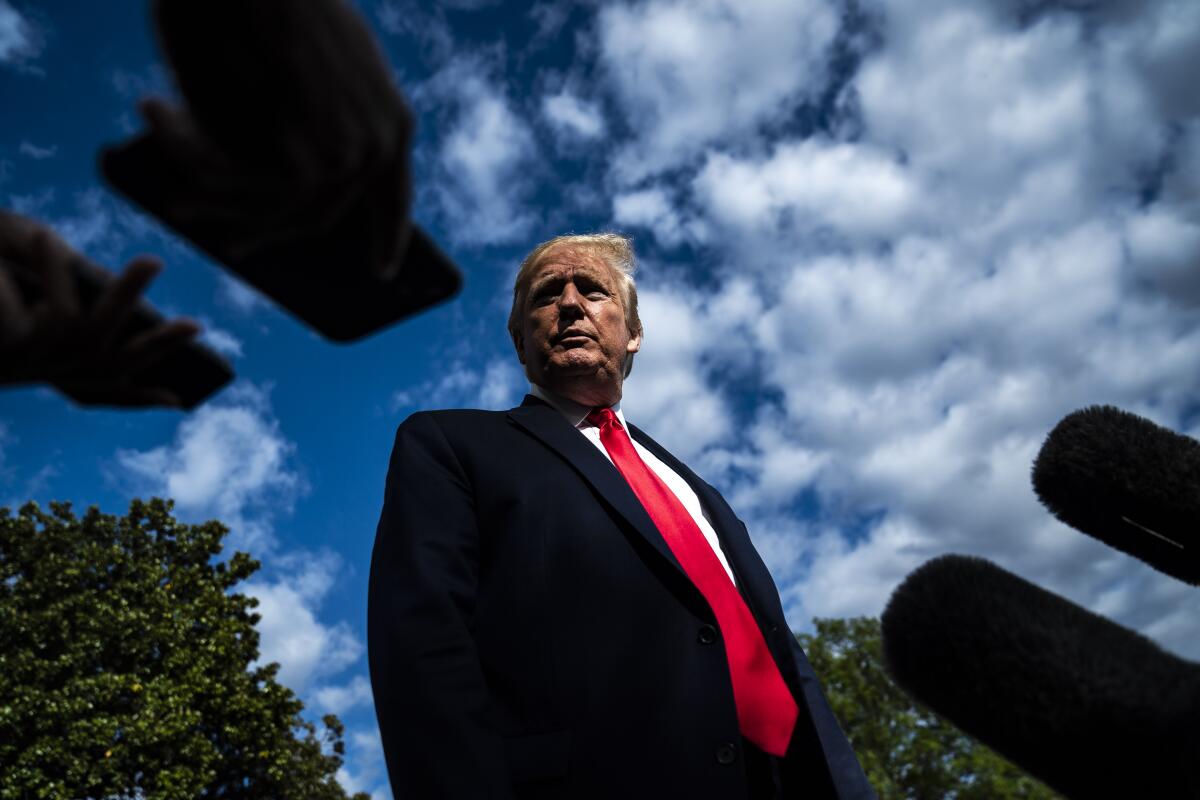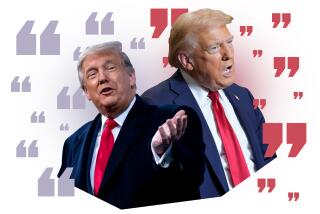Opinion: Trump’s support was historically partisan, but Obama and Bush weren’t that far behind

Gallup released its final poll numbers this week for President Trump, and not surprisingly, they were ugly. His average approval rating was only 41%, which set a new low for presidents since Gallup began measuring their popularity during Harry Truman’s tenure.
Trump also distinguished himself in a couple of other unenviable categories. His final approval rating, 34%, was higher only than Truman’s 32%. And his approval rating dropped 12% after the election, only the second president in the past 70 years to become less popular as a lame duck (the other was Jimmy Carter). It’s true that presidential approval has been trending downward since George H.W. Bush’s term, but Trump is so far below his predecessors, he bends the curve.
This isn’t exactly surprising. Nor is it shocking that Trump set a new high for partisan polarization. On average, 88% of Republicans approved of the job Trump was doing — tying Eisenhower for the highest average rating from either side of the aisle. On the other hand, only 7% of Democrats on average approved of Trump’s performance, the lowest rating ever from either side of the aisle.
The yawning, historic gap between Republican and Democratic approval was apparent throughout Trump’s presidency, and it was epitomized by the enormous turnout from both pro- and anti-Trump voters at the polls last year.
But it’s worth noting that, like the decline in approval ratings, the gap between how Republicans and Democrats view the president’s performance has been intensifying since George H.W. Bush left office. During President George W. Bush’s term, the average gap was a record 61 percentage points. For President Obama, it was 70 percentage points. And now for Trump, 81 percentage points.
As much as Democrats like to think of Trump as some sort of novelty, he was hardly sui generis when it comes to divisiveness. Instead, if Gallup’s tracking polls are to be believed, he merely continued a disturbing trend of Republicans and Democrats seeing the White House through different lenses.
The libertarian Cato Institute think tank pointed to a small study that illustrates this effect. Granted, it involved only 195 college students at three campuses, so take it with a grain of salt. The students were told about different presidential actions that the survey attributed to (or deliberately misattributed to) either Trump or Obama, including slapping tariffs on China and conducting lethal drone strikes in the Middle East. It found that the students liked or disliked each action based to a large measure on which president they were told was responsible for it, with Republicans largely favoring Trump’s actions and criticizing Obama’s, and Democrats doing the opposite.
Democrats might argue that Trump was more deliberately polarizing than any president in recent memory, and that’s certainly true. He tweeted his contempt for Democratic leaders, policies and states like California on a regular basis, and generally governed with an eye firmly on pleasing his GOP base. By catering relentlessly to his side of the partisan divide, he kept his approval rating high even when he did things that Republicans would have drawn and quartered Obama for, whether it be trying to pressure Ukraine into digging up dirt on a political rival or lying repeatedly to the public about the severity of the novel coronavirus.
Yet from Republicans’ point of view, Obama divided America through policy and rhetoric too. The soaring speeches that sent Democrats’ hearts aflutter struck many in the GOP as judgmental and condescending. They viewed the Affordable Care Act as an unprecedented intrusion on individuals’ power to make their own healthcare decisions, forcing Americans to buy more expensive insurance than they might need or want. Meanwhile, Obama’s free trade deals and the Paris climate-change accord all seemed to put the interests of American workers behind those of foreign workers.
There’s a distinct difference between a president who lashes out at his opponents in a public forum on a near daily basis and one who uses the bully pulpit to lay out ideals that not everyone may agree with. But the problem here isn’t just rhetoric — it’s also how Americans perceive the policy initiatives coming out of the White House. And we’re divided on policy, I would argue, because Congress has proved itself incapable of hammering out deals on major issues that produce win-win results.
Obama’s Deferred Action for Childhood Arrivals order shouldn’t have sparked controversy because he shouldn’t have felt compelled to issue it. Congress dropped the ball on the Dreamers, along with every other problem posed by outdated U.S. immigration laws. The Affordable Care Act is filled with provisions that Americans like, as polls increasingly show, yet Democrats couldn’t entice any Republicans to support its passage. Congress passed a massive tax overhaul measure in 1986 with broad bipartisan support, but seemingly every similar bill since then has moved ahead on party-line votes. The list goes on and on.
President-elect Joe Biden has pledged to be a president for all Americans, not just his supporters, which will be a welcome break from the last four years. His record reveals him to be a consensus builder, not a bridge burner, so he’s poised to pull the two parties closer together. But the trends shown in Gallup’s numbers suggest that it will take much more than a change in the Oval Office to narrow that widening gap.
More to Read
A cure for the common opinion
Get thought-provoking perspectives with our weekly newsletter.
You may occasionally receive promotional content from the Los Angeles Times.











